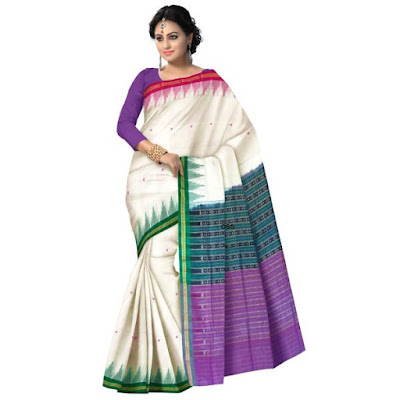India has a rich tradition of sarees that are worn by the women of this country for a wide range of occasions. From the earliest time, sarees have been an integral part of the Indian culture. Moreover, these garments are ideal for the tropical weather of this country as they keep the wearer perfectly comfortable throughout the day. Women in India wear sarees both for special occasions as well as for day to day purposes. The sarees that are made in different parts of India have their very own characteristic style and uniqueness. Moreover, the fabric of one type of saree also varies greatly from another type of saree.
Of the different types of sarees that are made in India, one of the most well known types is the Bomkai saree. Notable for its exquisite beauty and simplicity, the Bomkai saree is a testament to the rich saree manufacturing practices of Orissa. The Bomkai saree is also referred to as Sonepuri and is made on an extraordinarily beautiful fabric that is made by combining two different Odisha textile components. Insimple terms, Bomkai is made by a technique that involves creating an extra weft on a pit loom. The fabric used for Bomkai sarees is created by interweaving Ikat and embroidery seamlessly into each other. The motifs and themes used in Bomkai sarees are taken from tribal art and nature, which gives them a marvelous look that makes them ideal for aristocracy. The pallus of these sarees are adorned with intricate threadwork and the borders are frequently done in contrasting colors. These sarees are usually available in silk and cotton fabrics.
 |
| Traditional Bomkai Sarees available Online |
Traditional Bomkai sarees are crafted by the most adept artisans of Odisha who are known for creating the signature style of these garments. The basic elements of these sarees are created by using the needle in the most skillful ways. The Bomkai or Sonepuri sarees have their origins in Sonepur, a placelocated on the western parts of Odisha. Ever since early 1980s when this variety of saree first came into limelight, it was named after Sonepur, the village where they were originally discovered. The artisans of Odisha make use of the Jala technique on the handlooms to create the Bomkai sarees.
The art and craft of weaving had been present in Odisha since 600 B.C. and the scriptures found in theKhandagiri Caves bear testament to this truth. While the modern Bomkai saree has evolved over many decades, it can be said that the artisans of Odisha developed the skill of creating this Bomkai design(locally referred to as the Bandha design) by around 1980s without implementing any additional shedding mechanism. The Bomkai fabric with its exquisite finish and beauty was originally made for thearistocratic families and the local maharaja as well as the Brahmans of chikiti tahsilm of ganjam district.
The Bomkai design is created by using both the weft and warp and dyes are implemented according to the requirements. Only the warp is used for making the border design, and the weft is processed for making the anchal and palavas. Both the weft and warp are used for making the whole saree design. The traditional artisans of Odishastill make use of the traditional jaalas in order to weave the Bomkai sarees. The wooden jaalas are utilized for designing the sarees and are tied by the jaala bandhaks in a traditional manner. To make the Bomkai design, the yarn is properly tie dyed. However, at this stage the main focus is not on creating the patterns of the saree but to properly set the contrasting colors within the garment.

